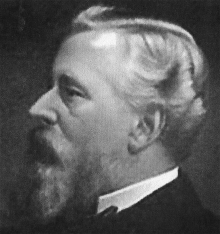
James Maxwell was born in Haslingden, Lancashire, England on 14 June 1838 and from 1852 to 1857 was articled to Thomas Holmes in Bury, Lancashire. He commenced independent practice in Bury in December 1857 and from 1868 was in partnership with William Charles Tuke (1841-1893) as Maxwell & Tuke in Manchester.
Maxwell was elected a Fellow of the Royal Institute of British Architects (FRIBA) in 1888. He was also a member of the Manchester Society of Architects. He died at his home, The Hollies, 179 Manchester Road, Bury on 28 September 1893.
Early work by Maxwell included six houses in Haslingden, Lancashire (1859); Manchester Assize Courts (1859); the Mechanics Institution in Haslingden, Lancashire (1859-60); a chapel in Bury, Lancashire (1860); Derby Arms in Bury, Lancashire (1860); four cottages in Whitefield (1860); Public Baths in Bury, Lancashire (1862-64); Church of St Stephen Grane near Haslingden, Lancashire (1864); Congregational Church and schools in Bury, Lancashire (1865-67); Independent Chapel in Edgworth, near Bolton, Lancashire (1865-67); Primitive Methodist Chapel in Bury, Lancashire (1866); Congregational Chapel and schools in Heywood, Lancashire (1866); Congregational schools in Radcliffe, Lancashire (1866-67); Congregational Sunday schools and Chapel House in Chapelfield, near Stand, Lancashire (1866-67); Co-operative Society Hall and Store in Darwen, Lancashire (1866-68).
____
See Maxwell & Tuke for later work by Maxwell
Directory of British Architects 1834-1914. Compiled by Antonia Brodie, et al. Volume 2: L-Z. London; New York: British Architectural Library, Royal Institute of British Architects/Continuum, 2001
‘Obituary’. Journal of the Royal Institute of British Architect vol. 1, 1893-94, p.116